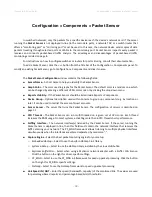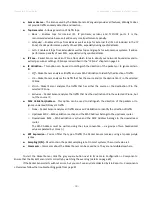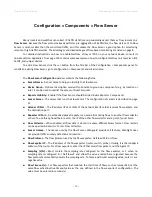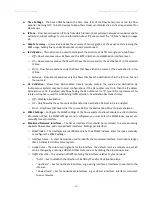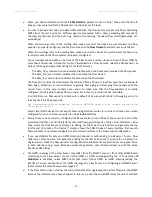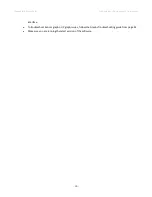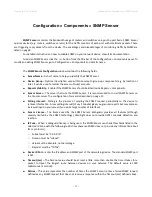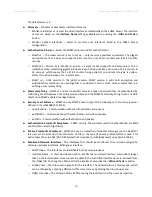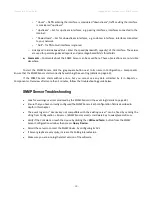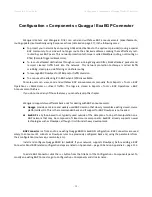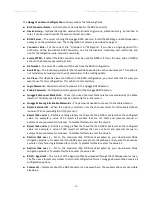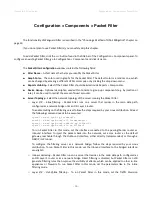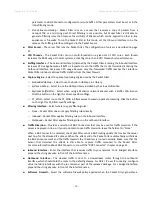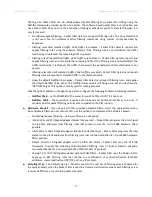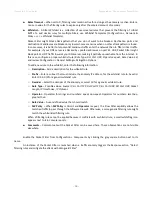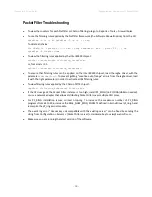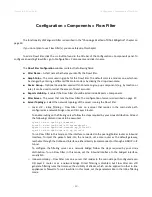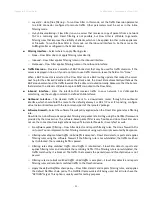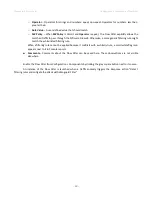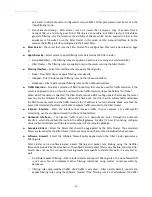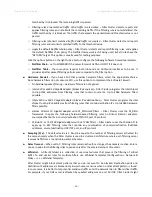
Wanguard 6.2 User Guide
Configuration » Components » Quagga / ExaBGP Connector
The
Quagga Connector Configuration
window contains the following fields:
●
BGP Connector Name
– A short name or description for the BGP Connector.
●
Device Group
– Optional description used within Console to group up components (e.g. by location or
role). It can be used to restrict the access of Guest accounts.
●
BGPd Server
– The server running the Quagga BGPd daemon. Install the WANbgp and WANsupervisor
packages on the selected server. The configuration of servers is described on page 37.
●
Connector Role
– Set the correct role, “Diversion” or “Mitigation”. If you have a single bgpd.conf for
both roles, define two distinct BGP Connectors, one for the diversion route-map and community and
one for the mitigation route-map and community.
●
Source/RTBH
– Enable if the BGP Connector must be used for S/RTBH. If this is the case, add an S/RTBH
action to the Response executed by Filter.
●
AS Number
– The same AS number with the one from the BGPd configuration.
●
Route Map
– The route-map parameter that should be appended to each announcement. This option is
not mandatory but widely used to add communities to the routing update.
●
AS View
– If multiple AS views are defined in the BGPd configuration, you must enter the AS view you
want to use for this configuration. This option is not mandatory.
●
Login Password
– Password needed to connect to the Quagga BGPd daemon.
●
Enable Password
– Configuration mode password of the Quagga BGPd daemon.
●
Quagga Zebra Local Black Hole
– Check if you need the local black hole feature provided by the Zebra
daemon. This rarely-used feature may be useful only for in-line servers.
●
Quagga Zebra Login & Enable Passwords
– The passwords needed to connect to the zebra daemon.
●
Reject External IPs
– When this option is selected, only the announcements for IPs/subnets defined
inside an IP Zone (excluding 0.0.0.0/0) are sent.
●
Reject IPv4 under /
– Restricts sending prefixes that have the IPv4 CIDR mask less than the configured
value. For example, a value of 32 rejects all prefixes that are not hosts and prevents manual or
automatic announcements of subnets. To disable this feature enter the value 0.
●
Reject IPv6 under /
– Restricts sending prefixes that have the IPv6 CIDR mask less than the configured
value. For example, a value of 128 rejects all prefixes that are not hosts and prevents manual or
automatic announcements of subnets. To disable this feature enter the value 0.
●
Restrict IPv4 over /
– Set to the maximum IPv4 CIDR mask accepted by your cloud-based DDoS
mitigation providers. For example, if your BGP peers accept only /24 prefixes, and you want to announce
a whole C class for a single attacked IP, set to 24. To disable this feature enter the value 32.
●
Restrict IPv6 over /
– Set to the maximum IPv6 CIDR mask accepted by your cloud-based DDoS
mitigation providers. To disable this feature enter the value 128.
●
BGPd - bgpd.conf
– The content of the bgpd.conf file downloaded through the WANsupervisor service.
The file uses a format very similar to Cisco IOS configuration format. Quagga documentation covers all
configuration options.
●
Comments
– Comments about the BGP Connector can be saved here. These observations are not visible
elsewhere.
- 52 -
Summary of Contents for wanguard 6.2
Page 1: ......

